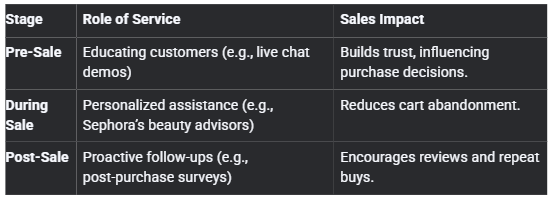Introduction
In today’s competitive market, businesses focus on marketing and pricing strategies to drive sales. However, one critical factor that directly influences sales performance is customer service. This guide explores the connection between customer service and sales, offering actionable insights for business growth.
Understanding the Connection
What is Customer Service?
Customer service includes the support provided to customers before, during, and after purchases. It involves resolving issues, answering questions, and ensuring satisfaction.
What is Sales Performance?
Sales performance is measured through metrics like revenue, conversion rates, customer acquisition costs, and retention rates.
Why Customer Service Matters for Sales
Great customer service fosters loyalty, drives repeat purchases, and enhances brand reputation—all of which boost sales.
Learn more about improving customer experience
How Customer Service Directly Affects Sales
1. Customer Retention
Fact: Stat: Acquiring a new customer costs 5–25x more than retaining an existing one (Harvard Business Review).
Impact: Loyal customers spend more, and resolving issues swiftly improves retention.
2. Upselling and Cross-Selling
Example: Amazon’s “Frequently Bought Together” feature encourages additional purchases. Knowledgeable service reps can suggest relevant products.
3. Encouraging Repeat Business
Fact: A 5% increase in retention can raise profits by 25–95% (Bain & Company). Satisfied customers return and recommend the business.
Indirect Benefits of Customer Service
1. Word-of-Mouth and Referrals
Stat: 92% of consumers trust recommendations from friends over ads (Nielsen).
Impact: Positive experiences lead to organic referrals.
2. Building a Strong Brand Reputation
Example: Ritz-Carlton’s excellent service allows them to justify premium pricing.
Explore brand-building strategies
The Cost of Poor Customer Service
Fact: 33% of customers will switch brands after one bad experience (PwC).
Example: United Airlines’ 2017 incident caused a $1.4 billion stock drop.
Customer Service Throughout the Buying Journey
Leveraging Technology
CRM Systems: Tools like Salesforce improve personalized interactions.
AI Chatbots: Handle routine queries, allowing reps to focus on high-value tasks.
Real-Time Assistance: AI-driven insights help reps enhance service quality.
Check out the latest AI tools for customer support
Training and Employee Empowerment
Example: Ritz-Carlton empowers employees to resolve issues up to $2,000 per guest, improving satisfaction and loyalty.
Key Metrics to Measure Success
Net Promoter Score (NPS): Indicates customer loyalty and revenue potential.
Customer Satisfaction Score (CSAT): Higher scores correlate with increased lifetime value.
Strategies to Align Customer Service with Sales
Integrate Sales and Support Teams to create a seamless customer experience.
Leverage Customer Feedback to identify upselling opportunities.
Omnichannel Support ensures consistent service across email, social media, and chat.
Real-World Success Stories
Zappos: 75% of purchases come from repeat customers due to hassle-free returns and 24/7 support.
Starbucks: Personalized customer service drives loyalty and revenue growth.
Avoid These Common Pitfalls
Ignoring Customer Complaints: Dissatisfied customers share negative experiences widely.
Lack of Employee Training: Poor service damages brand credibility.
Future Trends in Customer Service.
AI-Driven Personalization: Predictive analytics anticipate customer needs.
Social Media Support: Quick responses on social media improve customer satisfaction.
Conclusion
Customer service is a revenue driver, not a cost center. By prioritizing empathetic, efficient service, businesses can boost retention, referrals, and sales. In today’s experience-driven market, integrating service into your sales strategy is essential.
Key Takeaway: Invest in customer service, build strong relationships, and watch your sales grow! 🚀





Top comments (0)